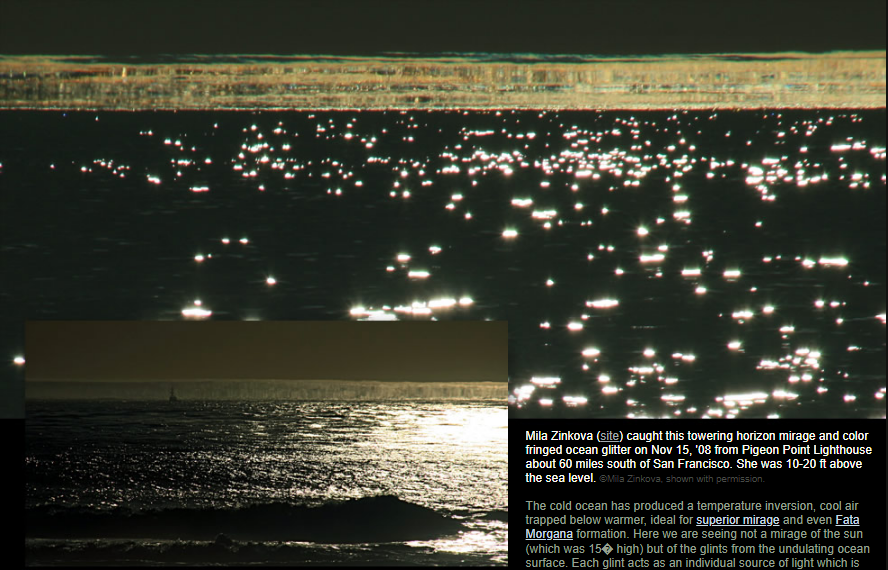Chromatic Glitter
Chromatic Glitter: Exploring the Phenomenon in Atmospheric Optics
Atmospheric optics never fails to captivate us with its stunning displays of light and color. One such mesmerizing phenomenon is known as "chromatic glitter." In this article, we will delve deeper into the intricacies of chromatic glitter and uncover the science behind its enchanting appearance.
Chromatic glitter occurs when a temperature inversion takes place over a cold body of water, such as the ocean. This phenomenon creates a layer of cool air that becomes trapped beneath a warmer layer. The temperature difference between these layers creates an ideal environment for the formation of superior mirages and even Fata Morgana, a complex mirage that distorts distant objects. These atmospheric conditions set the stage for the emergence of chromatic glitter.
When observing chromatic glitter, we are not witnessing a mirage of the sun itself, but rather the glints of light reflecting off the undulating surface of the ocean. Each glint acts as an individual source of light, which is refracted and mirrored by the intervening air. The refraction of light is responsible for the mesmerizing display of colors that make up chromatic glitter.
The refraction of light in chromatic glitter is particularly fascinating due to dispersion, the phenomenon where different colors of light are refracted at different angles. As a result, we observe a striking upper blue-green edge in the mirage, which arises from the stronger refraction of green and blue rays compared to red. This dispersion effect enhances the vividness of the colors present in chromatic glitter.
Moreover, parts of the mirage can vertically magnify the dispersion of colors, further intensifying the visual spectacle. Even the lower glints in chromatic glitter exhibit upper green edges and lower red edges, highlighting the strength of refraction in this atmospheric phenomenon.
To witness chromatic glitter in all its glory, one needs to be in the right place at the right time. Coastal regions with cold ocean currents are ideal locations for observing this phenomenon. The occurrence of temperature inversions, coupled with the undulating surface of the ocean, creates the perfect conditions for chromatic glitter to manifest.
Photographers and nature enthusiasts alike often seek out these coastal locations to capture the beauty of chromatic glitter. The interplay of light, color, and atmospheric conditions offers a unique opportunity to witness and document this captivating display.
It is worth noting that chromatic glitter can vary in its appearance depending on various factors, such as the angle of the sun, the clarity of the atmosphere, and the properties of the water surface. Each observation presents a new and exciting opportunity to explore the ever-changing dynamics of atmospheric optics.
In conclusion, chromatic glitter is a fascinating phenomenon within atmospheric optics that mesmerizes us with its vibrant display of colors. By understanding the science behind it, we can appreciate the intricate interplay of light, refraction, and dispersion that brings this enchanting spectacle to life. So next time you find yourself near a cold body of water, keep an eye out for chromatic glitter and immerse yourself in the wonders of atmospheric optics.

Mila Zinkova (site) caught this towering horizon mirage and color fringed ocean glitter on Nov 15, '08 from Pigeon Point Lighthouse about 60 miles south of San Francisco. She was 10-20 ft above the sea level. ©Mila Zinkova, shown with permission.

The cold ocean has produced a temperature inversion, cool air trapped below warmer, ideal for superior mirage and even Fata Morgana formation. Here we are seeing not a mirage of the sun (which was 15� high) but of the glints from the undulating ocean surface. Each glint acts as an individual source of light which is refracted and miraged by the intervening air. The upper blue-green edge to the mirage arises from the stronger refraction of green and blue rays compared with red (dispersion). Parts of the mirage also vertically magnify the color dispersion. The refraction is so strong that even the lower glints have upper green and lower red edges.
Note: this article has been automatically converted from the old site and may not appear as intended. You can find the original article here.
Reference Atmospheric Optics
If you use any of the definitions, information, or data presented on Atmospheric Optics, please copy the link or reference below to properly credit us as the reference source. Thank you!
-
<a href="https://atoptics.co.uk/blog/chromatic-glitter/">Chromatic Glitter</a>
-
"Chromatic Glitter". Atmospheric Optics. Accessed on December 19, 2024. https://atoptics.co.uk/blog/chromatic-glitter/.
-
"Chromatic Glitter". Atmospheric Optics, https://atoptics.co.uk/blog/chromatic-glitter/. Accessed 19 December, 2024
-
Chromatic Glitter. Atmospheric Optics. Retrieved from https://atoptics.co.uk/blog/chromatic-glitter/.